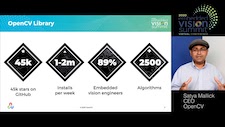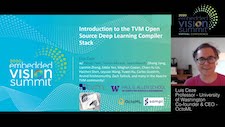| LETTER FROM THE EDITOR |
Dear Colleague,
On Tuesday, October 5 at 9 am PT, Eta Compute will deliver the free webinar “How Battery-powered Intelligent Vision is Bringing AI to the IoT” in partnership with the Edge AI and Vision Alliance. In today’s landscape for the enterprise Internet of Things (IoT), the promise of artificial intelligence (AI) is as yet unfulfilled. Existing solutions are complex and expensive to deploy and do not address the numerous cases where low power consumption is critical. In this webinar, you’ll learn about various applications for AI at the edge, as well as how battery-operated and AI-based computer vision can solve real-world problems and create business value. A case study example will highlight Eta Compute’s space monitoring sensor, Tally. By providing high-accuracy, reliable local insights in an easy-to-deploy form factor, Tally helps enterprises in building, hospitality, and retail make better decisions and optimize occupants’ space and well-being. For more information and to register, please see the event page.
Brian Dipert
Editor-In-Chief, Edge AI and Vision Alliance |
| BUSINESS OPPORTUNITIES |
|
Using Learning at the Edge to Deliver Business Value
Learning at the edge is the next frontier of edge AI. Unlike inference, so far it has stayed on the fringe of industry focus, usually thought of as infeasible for practical applications. In this talk, Vera Serdiukova, Product Manager in the Advanced AI team at LG Electronics, sheds light on the benefits and challenges of learning at the edge, as well as practical insights on unlocking its potential and using it to create business value.
Embedded Vision: Where’s The Money?
Vision technology is going everywhere–from retail to agriculture, and from autonomous vehicles to healthcare. But which markets are driving the most revenue and profit for companies delivering the technologies that enable vision in these applications? In this presentation, Rudy Burger, Managing Partner at Woodside Capital Partners, explores the answers to this question today, and examines how the opportunities are likely to evolve in the coming years. He also provides an update on venture and M&A activity in the embedded vision sector.
|
| OPEN SOURCE DEVELOPMENT |
|
OpenCV: Rapid Growth and Evolution Beyond the Library
The last 20 years of OpenCV were dedicated to building the world’s largest high-performance computer vision library. Now, the organization is fast expanding beyond the flagship library to better serve the computer vision and artificial intelligence community through courseware, hardware, services, and community initiatives. OpenCV is becoming the place where people come to learn about the best computer vision resources. In this presentation from Dr. Satya Mallick, CEO of OpenCV.org and OpenCV.ai, you’ll learn more about:
- Courseware: The organization launched the best computer vision courses in the world with its three-course series that has over 2,500 students registered in more than 5,000 courses
- The OpenCV AI Kit (OAK), an insanely powerful smart camera capable of neural inference and depth perception in real-time—had a record-breaking Kickstarter campaign
- OpenCV Partnerships: Development and hardware partnerships (very useful for hardware manufacturers for continuous OpenCV compliance testing)
- The AI model marketplace
- Consulting services via OpenCV.ai, and
- Community: How OpenCV aims to build a community of more than 1M developers in a year.
Introduction to the TVM Open Source Deep Learning Compiler Stack
There is an increasing need to bring machine learning to a wide diversity of hardware devices. Current frameworks rely on vendor-specific operator libraries and optimize for a narrow range of server-class GPUs. Deploying workloads to new platforms — such as mobile phones, embedded devices, and accelerators — requires significant manual effort. In this talk, Luis Ceze, a Professor in the Paul G. Allen School of Computer Science and Engineering at the University of Washington, co-founder and CEO of OctoML, and Venture Partner at Madrona Venture Group, presents his work on the TVM stack, which exposes graph- and operator-level optimizations to provide performance portability for deep learning workloads across diverse hardware back-ends. TVM solves optimization challenges specific to deep learning, such as high-level operator fusion, mapping to arbitrary hardware primitives and memory latency hiding. It also automates optimization of low-level programs to hardware characteristics by employing a novel, learning-based cost modeling method for rapid exploration of optimizations.
|
| UPCOMING INDUSTRY EVENTS |
|
How Battery-powered Intelligent Vision is Bringing AI to the IoT – Eta Compute Webinar: October 5, 2021, 9:00 am PT
More Events
|
| FEATURED NEWS |
|
Blaize and eYs3D Microelectronics Unveil Reference Design for Enhanced 3D Computer Vision for Edge AI
Teledyne Announces Low-cost, High-performance Quad Linear CMOS Sensor Family
Lattice Semiconductor’s Radiant 3.0 Design Software Enhances Ease of Use to Accelerate FPGA Designs
Xilinx Extends Edge Compute Leadership with Even Higher AI Performance-per-Watt
Upcoming Webinar from FRAMOS Explores Debugging Imaging Systems
More News
|
| EDGE AI AND VISION PRODUCT OF THE YEAR WINNER SHOWCASE |
|
Luxonis and OpenCV OpenCV AI Kit with Depth (Best Camera or Sensor)
Luxonis and OpenCV’s OpenCV AI Kit with Depth is the 2021 Edge AI and Vision Product of the Year Award Winner in the Cameras and Sensors category. The OpenCV AI Kit (OAK) is a complete edge AI solution unlike any on the market today, at a price point unmatched in the industry. OAK is the most popular AI-related Kickstarter campaign in history, raising over $1.3 million from 6,500 backers. It is also the basis for the largest AI competition in history, the OpenCV AI Competition 2021 sponsored by Microsoft Azure and Intel, which attracted over 1,200 project submissions from around the world. The OpenCV AI Kit combines the power of the Intel Myriad X Visual Processing Unit with a 4K color camera and HD stereo depth cameras in one single, aluminum-enclosed package, making it suitable for use in practically any environment. OAK is also proudly open source and already supports an ecosystem of devices including versions with on-board Wi-Fi and Bluetooth. And OAK does it all at $149 for the single-camera version and $299 for the OAK-D stereo depth version.
Please see here for more information on the Luxonis and OpenCV OpenCV AI Kit. The Edge AI and Vision Product of the Year Awards celebrate the innovation of the industry’s leading companies that are developing and enabling the next generation of edge AI and computer vision products. Winning a Product of the Year award recognizes a company’s leadership in edge AI and computer vision as evaluated by independent industry experts. |








